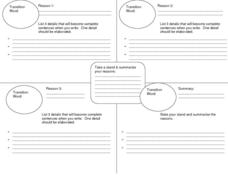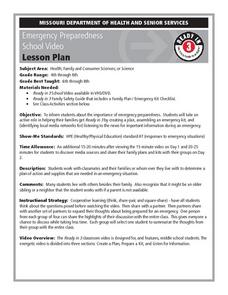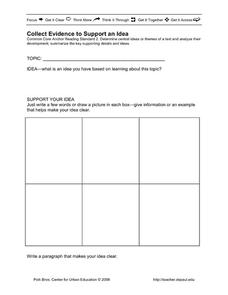jc-schools
The Persuasive Writing Graphic Organizer
A variation of a standard graphic organizer for a five-paragraph essay, young writers may find this style of organization helpful while drafting their writing. Some key features of this particular organizer are sections for transition...
Curated OER
1984 - Chapter 3-4 Questions
Why does Winston think sorrow and tragedy are no longer possible? What is a memory hole, and what is its purpose? Although designed as an assessment, these questions on chapters three and four of the Orwell’s dystopian classic could also...
Curated OER
Family Emergency Preparedness
Students watch a video prior to developing a family emergency preparedness plan and kit. They decide with their families what local media sources they would use to get information during an emergency situation.
Curated OER
Earth's Poles
In this Earth's Poles worksheet, students survey, examine and dissect the North and South Magnetic Poles, the Earth's axis and summarize the Aurora legends. Students research six directives involving space weather and predicting answers.
Polk Bros Foundation
I Can Comprehend a Paragraph, then a Page/Section in a Text
Help your class tackle chunks of text with a simple graphic organizer. Pupils read three paragraphs and, as they read, draw pictures in the provided boxes that demonstrate what each paragraph says. There are three boxes on the page and...
Polk Bros Foundation
Collect Evidence to Support an Idea
In order to support an idea, writers must use evidence. Your class members can prepare their evidence with this basic worksheet. Writers note down the topic they are learning about and their own idea. Next, they come up with information...
Polk Bros Foundation
Analyze History
Determining the central idea of a historical event or theme involves identifying key points of information, such as the people and place involved in the history, challenges faced, and choices made. Your young historians can use this...
Polk Bros Foundation
I Can Identify a Nonfiction Writer's Main Idea and Supporting Examples
Use this page to quickly identify the central idea of a text and organize ideas for writing an informational or explanatory text. The worksheet is split into two parts. In the first part, pupils note down the main idea and supporting...
iCivics
The Executive Command
Take on the role of president of the United States with this interactive online game, which will acquaint your learners with the various responsibilities of the executive branch of government. While not an in-depth or complex resource,...
Curated OER
Knocked Out by Trout
Learners work in pairs and read an article about the pacific tree frogs being knocked out by the nonnative trout. In this invasive species instructional activity, students create a graphic organizer to record their findings. Once the...
Curated OER
INTERNET ASSIGNMENT: THE DAY DIZZY DUCKLING GOT LOST
For this reading / writing worksheet, students use the Internet to read a story about ducks. They then summarize what they have read under each related illustration. Seven story elements are provided, along with one summarizing statement.
Curated OER
Reading Comprehension Jobs
Students practice different strategies to help them draw meaning from their reading. Students, divided into groups, read an assigned text selection. Each group member provided a summary of what they have been read based on a particular...
Curated OER
What's Important?
Students, through teacher modeling and guided practice, explore four steps/rules of summarizing. In groups, they read a short passage and then, by applying the summarization rules and skills, write an effective summary of it.
Curated OER
Sensational Summarizers
Students study strategies that aid comprehension. They focus on the main ideas of a passage and eliminate unnecessary and repetitive information. They substitute super ordinate terms for a list of items and create a topic sentence.
Curated OER
Predicting and Summarizing Leads to Comprehension
Students practice making predictions in order to aid in the creation of meaning when reading text. Before reading a passage, they make a prediction based on previous actions as to what will happen next in the text. Students compare and...
Curated OER
How to Summarize
Students review techniques on how to read a passage smoothly making the words connect, and with expression. They then read the instruction to the chapter in their science book and answer questions that are written on the board. They...
Curated OER
Summarizing Political Cartoons by Using Standard Parts of Speech
Students analyze a political cartoon, and at the same time cover the basic parts of speech, in order to view a cartoon and determine its subject, action verb, and object.
Pennsylvania Department of Education
Using Literary Elements to Compare Fiction Texts
Students explore language arts by reading and reflecting on literary examples. In this fiction writing lesson, students read several different cultural versions of the story "Cinderella" and discuss their interaction with the story and...
Curated OER
Using Blood Tests to Identify Babies and Criminals
Students solve a crime by matching a suspect's blood type to physical evidence collected at the crime scene. In this forensic science instructional activity, students identify the different blood types. They explain how blood tests work.
Curated OER
Learning to Summarize a Story
Students with hearing loss read independently and understand what is being read to them. For this independent reading lesson plan, students sequence and discuss the book that is read.
Curated OER
Using "Why Mosquitoes Buzz in People's Ears" to Teach Cause and Effect
Learners discuss cause and effect relationships and the chain reaction involved before listening to the story "Why Mosquitoes Buzz in People's Ears". Students create flow charts to show the chain reactions of causes and effects in the...
Curated OER
Making Use of Fieldwork
Students transcribe, analyze, and archive fieldwork and create a team project drawn from fieldwork. They brainstorm a list of reasons why preservation of collected materials is important and explore the online archives of the American...
Curated OER
Analyzing Artifacts Using Bloom's Taxonomy
Seventh graders apply Blooms Taxonomy to analyze a collection of artifacts. They define and discuss the nature of artifacts and work in groups to complete handouts. Students analyze an object (stone pipe) on a mystery artifact analysis...
Curated OER
Use Literature to Teach Tolerance
Students listen as teachers read a different book or a different passage that focuses on the theme of tolerance. Students then write a paragraph each day to tell how that day's book/passage taught them the importance of tolerance.
Other popular searches
- Summarizing Using Stellaluna
- Summarizing Using 5 Ws
- Summarizing Using Key Ideas
- Summarizing Using Stealing
- Summarizing Using 5 Sw























